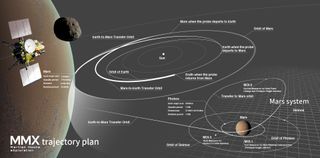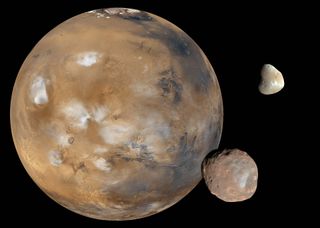
New Japanese spacecraft aims to explore the mysterious moons of Mars
Those two moons of Mars are celestially eccentric oddities.

Mars itself is a world of puzzlement, particularly when it comes to whether or not the planet is the home of ancient or even present-day life. But put that aside for the moment. Even without the possible presence of life, the Red Planet is mysterious enough due to the fact that it's circled by a couple of oddballs.
Nobody knows for sure how the two moons of Mars, Phobos and Deimos, got where they are or what they are made of.
But now an audacious, adventurous undertaking is being readied for launch that can help us better understand the moons of Mars. Japan's planned Martian Moons eXploration (MMX) spacecraft mission involves drilling and sampling Phobos, then rocketing the coveted collectibles back to Earth.
Related: This is our 1st detailed look at Mars' most mysterious moon Deimos (photos)
On-site detective work
Why all the fuss? Those two moons of Mars are celestially eccentric oddities. Both moons are in nearly circular equatorial orbits; Phobos slowly spiraling into Mars while Deimos is gradually spiraling away.
As theories go, they might be captured asteroids following the formation of Mars. Or perhaps they are leftovers from a huge impact with Mars that then coalesced.
The Japan Aerospace Exploration Agency's MMX is geared to help sort out this dilemma by on-site detective work. The mission involves a notable level of cooperation with Europe and the United States, including the development of onboard science instruments and hardware.
Get the Space.com Newsletter
Breaking space news, the latest updates on rocket launches, skywatching events and more!
If all remains on schedule, MMX heads to its destination next year. About one year after launch, the MMX spacecraft will arrive at Mars to start its long-distance duties. Once its mission is complete, the probe will then journey back to Earth for nearly a year, delivering the collected samples home in 2029. Its sample return capsule will come to to full-stop within a targeted zone of remote outback in Australia.

Catch and release
Nearly a dozen scientific instruments will be onboard the MMX spacecraft, seven of which are dedicated to remote sensing and on-the-spot observation of the Martian moons. Two are sampling mechanisms for collecting material from Phobos, and two instruments are designed to test and develop exploration technology.
The MMX spacecraft is outfitted with two different mechanisms for collecting material from Phobos: The C (corer) Sampler and P (pneumatic) Sampler. The Phobos goodies from the moon's surface are to be stored in a sample return capsule.
The corer sampler uses a robotic arm that will gather subsurface material from the Martian moon, storing that material in a tube for placement in the sample return capsule.
The pneumatic sampler approach uses pressurized gas to loft material from the surface of Phobos for transfer into the sample container.
Hard or fluffy?
Yet another MMX mission component is a German-French rover being jointly developed by the Centre National d'Etudes Spatiales (CNES) in France and the German Aerospace Center (DLR).
To be dropped from an altitude of between roughly 130 feet to nearly 330 feet (40 and 100 meters) above Phobos, this robot will autonomously upright itself and do its business for some three months. During that time, the rover will approach scientific targets of interest, helping to discern which specimens of Phobos will be collected by the mother spacecraft for hauling to Earth in its return module.
But dealing with Phobos first-hand won't be easy.
The closer of the two heavily-cratered Martian moons, Phobos is the largest of the twosome at 17 x 14 x 11 miles (27 by 22 by 18 kilometers) in diameter. It circuits the Red Planet three times a day. Phobos is in a microgravity environment, having just 1/2000th of Earth's gravity.
What the MMX spacecraft will find there isn't a sure bet. Will the moon's surface material be hard enough to land on, or will be be soft and fluffy?

Surface changes
Terik Daly is a planetary scientist at the Johns Hopkins University Applied Physics Laboratory (APL) in Laurel, Maryland and is on the MMX science working team. Selected early this year as a NASA-funded participating scientist, he will search for surface changes on Phobos and Deimos by comparing MMX photo data with past imagery of the two moons.
"The MMX mission is ambitious," Daly told Space.com, "no one has ever returned samples from the moons of Mars," pointing out that the MMX mission builds upon JAXA's successful Hayabusa and Hayabusa2 missions, which returned samples from two near-Earth asteroids Itokawa (June 2010) and Ryugu (December 2020).
"One of the big questions is whether Phobos and Deimos are captured asteroids or the aftermath of a giant impact at Mars," Daly said. "Being able to answer that question will help us better understand the origin and evolution of the solar system, and bringing back samples from Phobos will help resolve that mystery."
Phobos 101
APL's David Lawrence is the science lead for the MMX mission's GAmma-rays and NEutrons (MEGANE) gamma-ray and neutron spectrometer. It will gauge the elemental composition of Mars' moon Phobos using gamma-rays and neutrons.
"Right now, we know little to no information about Phobos' elemental composition," Lawrence told Space.com, "and yet this information is key for understanding how Phobos formed."
In Phobos 101 fashion, Lawrence said there's one "back of the envelope" way to appraise how composition helps decide between the two theories.
"If Phobos formed via a giant impact, it likely would have gotten quite warm, and baked off easily volatilized elements. In contrast, if Phobos is a captured object, maybe from the more volatile rich outer solar system, then one expects such elements to have higher abundances," said Lawrence.

Legwork
Another NASA-sponsored piece of hardware on MMX is the P-Sampler designed by Honeybee Robotics.
This equipment is mounted along the leg of the MMX lander, crafted to perform sampling operations as soon as five seconds after spacecraft landing on Phobos and up to three seconds before liftoff.
"Two of the greatest challenges of sampling on Phobos are very low gravity and unknown properties of Phobos regolith at the scale of the sampling system," said Kris Zacny vice president of the company's exploration systems and a senior research scientist. "The Pneumatic Sampler was designed to address both challenges," he told Space.com.
Excavation: stir up and loft
Zacny said the use of compressed nitrogen gas to stir up and loft regolith into a sample container solves the unknown nature of regolith.
Since the pneumatic system is fundamentally a rocket engine that generates thrust, the Honeybee Robotics group also had to eliminate resulting thrust to make the system suitable for low gravity. This was achieved, Zacny said, by implementing additional gas nozzles that were pointed up — in the opposite direction to the excavation nozzles that were pointed down.
"To verify that the Pneumatic Sampler is ready for the mission, we did a lot of tests in a vacuum chamber with Phobos regolith simulant provided by Exolith lab at the University of Central Florida," Zacny said.
As far as the overall MMX mission itself, APL's Lawrence said it is indeed a bold and ambitious undertaking, "but of course, that is what makes it exciting."
Given the two past, highly-successful sample return missions to asteroids by Japan, "this is a great next step for JAXA to show their prowess in carrying out such planetary science missions."
Join our Space Forums to keep talking space on the latest missions, night sky and more! And if you have a news tip, correction or comment, let us know at: community@space.com.

Leonard David is an award-winning space journalist who has been reporting on space activities for more than 50 years. Currently writing as Space.com's Space Insider Columnist among his other projects, Leonard has authored numerous books on space exploration, Mars missions and more, with his latest being "Moon Rush: The New Space Race" published in 2019 by National Geographic. He also wrote "Mars: Our Future on the Red Planet" released in 2016 by National Geographic. Leonard has served as a correspondent for SpaceNews, Scientific American and Aerospace America for the AIAA. He has received many awards, including the first Ordway Award for Sustained Excellence in Spaceflight History in 2015 at the AAS Wernher von Braun Memorial Symposium. You can find out Leonard's latest project at his website and on Twitter.
